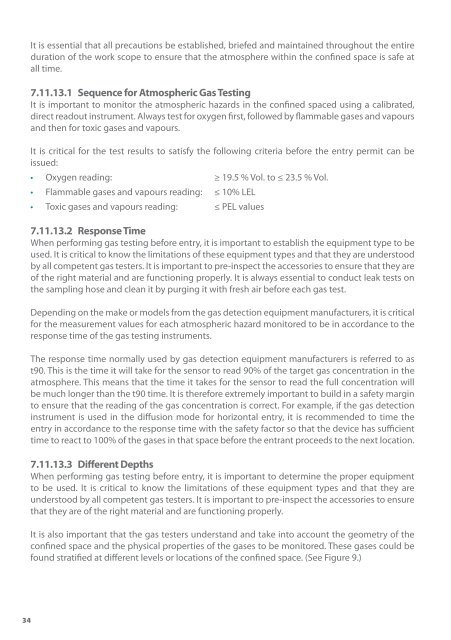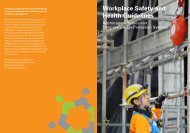Confined Spaces - Workplace Safety and Health Council
Confined Spaces - Workplace Safety and Health Council
Confined Spaces - Workplace Safety and Health Council
- No tags were found...
Create successful ePaper yourself
Turn your PDF publications into a flip-book with our unique Google optimized e-Paper software.
It is essential that all precautions be established, briefed <strong>and</strong> maintained throughout the entireduration of the work scope to ensure that the atmosphere within the confined space is safe atall time.7.11.13.1 Sequence for Atmospheric Gas TestingIt is important to monitor the atmospheric hazards in the confined spaced using a calibrated,direct readout instrument. Always test for oxygen first, followed by flammable gases <strong>and</strong> vapours<strong>and</strong> then for toxic gases <strong>and</strong> vapours.It is critical for the test results to satisfy the following criteria before the entry permit can beissued:• Oxygen reading: ≥ 19.5 % Vol. to ≤ 23.5 % Vol.• Flammable gases <strong>and</strong> vapours reading: ≤ 10% LEL• Toxic gases <strong>and</strong> vapours reading: ≤ PEL values7.11.13.2 Response TimeWhen performing gas testing before entry, it is important to establish the equipment type to beused. It is critical to know the limitations of these equipment types <strong>and</strong> that they are understoodby all competent gas testers. It is important to pre-inspect the accessories to ensure that they areof the right material <strong>and</strong> are functioning properly. It is always essential to conduct leak tests onthe sampling hose <strong>and</strong> clean it by purging it with fresh air before each gas test.Depending on the make or models from the gas detection equipment manufacturers, it is criticalfor the measurement values for each atmospheric hazard monitored to be in accordance to theresponse time of the gas testing instruments.The response time normally used by gas detection equipment manufacturers is referred to ast90. This is the time it will take for the sensor to read 90% of the target gas concentration in theatmosphere. This means that the time it takes for the sensor to read the full concentration willbe much longer than the t90 time. It is therefore extremely important to build in a safety marginto ensure that the reading of the gas concentration is correct. For example, if the gas detectioninstrument is used in the diffusion mode for horizontal entry, it is recommended to time theentry in accordance to the response time with the safety factor so that the device has sufficienttime to react to 100% of the gases in that space before the entrant proceeds to the next location.7.11.13.3 Different DepthsWhen performing gas testing before entry, it is important to determine the proper equipmentto be used. It is critical to know the limitations of these equipment types <strong>and</strong> that they areunderstood by all competent gas testers. It is important to pre-inspect the accessories to ensurethat they are of the right material <strong>and</strong> are functioning properly.It is also important that the gas testers underst<strong>and</strong> <strong>and</strong> take into account the geometry of theconfined space <strong>and</strong> the physical properties of the gases to be monitored. These gases could befound stratified at different levels or locations of the confined space. (See Figure 9.)Figure 9: Test air at 3 or more elevations: top, mid-point <strong>and</strong> bottom.The general rule of thumb for gas testing using sampling hose for a vertical or horizontal entry is10 seconds for each metre of the sampling hose. Alternatively, the following can be used to workout the sampling time required:Factors to consider:• Sampling Distance;• Internal/External PumpwCapacity; <strong>and</strong>• Diameter of the sampling hose.1. Lighter than air (for e.g., methane)2. Same as air (for e.g., carbon monoxide)3. Heavier than air (for e.g., hydrogen sulphide)Example:Sampling hose length: 30 metres; Pump Capacity: 0.5 litres/min; Hose Diameter: 0.6 cm.• Area = πr 2• Area = 3.14 x 0.3 x 0.3 = 0.283 cm 2• Total Volume = 3000 x 0.283 = 849 cm 3• Sampling time = 849/500 = 1.7 min (or 102 sec)If the sampling is done manually by using a rubber h<strong>and</strong> pump, it is important to know what airvolume is drawn per stroke. Typically, the volume is 40cm 3 or more. When using long hoses, itis important to know the number of pump strokes required for the gas to reach the instrumentfrom the point of sampling.It is recommended to observe the response time required by the gas instrument <strong>and</strong> the totalsampling time in accordance with the sampling depth. Wait until the reading is stabilised beforerecording the readout display on the gas detector instrument.34 35
















